Surya Namaskar

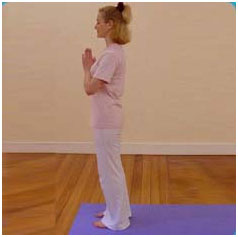
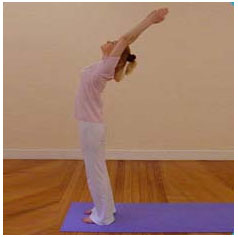
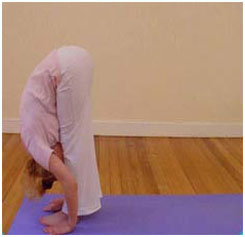

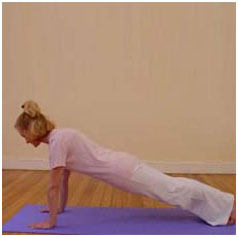
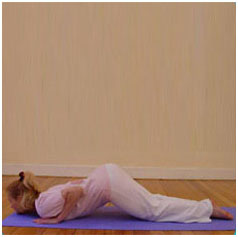
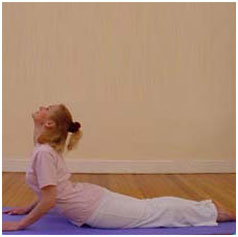
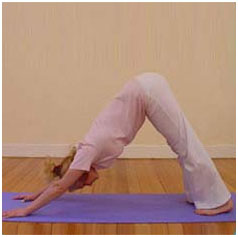
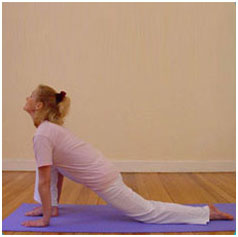
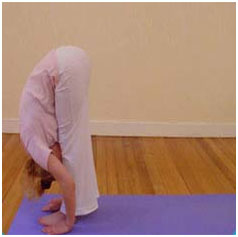
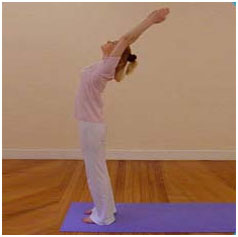
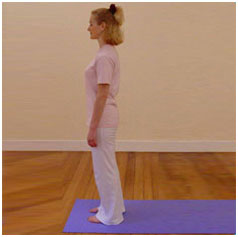
By Wikipedia,
Surya Namaskar (Sanskrit: सूर्यनमस्कार IAST: Sūrya Namaskār), Salute to the Sun or Sun Salutation, is a practice in yoga as exercise incorporating a sequence of some twelve gracefully linked asanas The asana sequence originated in the Hatha Yoga tradition on 9th century in India. The basic sequence involves moving from a standing position into Downward and Upward Dog poses and then back to the standing position, but many variations are possible. The set of 12 asanas is dedicated to the vedic-hindu solar deity Surya. In some Indian traditions, the positions are each associated with a different mantra.
Etymology and origins
The name Surya Namaskar is from the Sanskrit सूर्य Sūrya, "Sun" and नमस्कार Namaskār, "Greeting" or "Salute" Surya is the Hindu god of the sun This identifies the Sun as the soul and source of all life. Chandra Namaskar is similarly from Sanskrit चन्द्र Chandra, "Moon".[9]
The origins of Surya Namaskar are vague; Indian tradition connects the 17th century saint Samarth Ramdass with Surya Namaskar exercises, without defining what movements were involved.In the 1920s, Bhawanrao Shriniwasrao Pant Pratinidhi, the Rajah of Aundh, popularized and named the practice, describing it in his 1928 book The Ten-Point Way to Health: Surya Namaskars. It has been asserted that Pant Pratinidhi invented it, but Pant stated that it was already a commonplace Marathi tradition.
Ancient but simpler Sun salutations such as Aditya Hridayam, described in the "Yuddha Kaanda" Canto 107 of the Ramayana, are not related to the modern sequence The anthropologist Joseph Alter states that Surya Namaskar was not recorded in any Haṭha yoga text before the 19th century. At that time, Surya Namaskar was not considered to be yoga, and its postures were not considered asanas; the pioneer of yoga as exercise Yogendra wrote criticising the "indiscriminate" mixing of sun salutation with yoga as the "ill-informed" were doing.
The yoga scholar-practitioner Norman Sjoman suggested that Krishnamacharya, "the father of modern yoga",]used the traditional and "very old"[22] Indian wrestlers' exercises called dands (Sanskrit: दण्ड daṇḍ, a staff), described in the 1896 Vyayama Dipika,[23] as the basis for the sequence and for his transitioning vinyasas.Different dands closely resemble the Surya Namaskar asanas Tadasana, Padahastasana, Caturanga Dandasana, and Bhujangasana.Krishnamacharya was aware of Surya Namaskar, since regular classes were held in the hall adjacent to his Yogasala in the Rajah of Mysore's palace. His students K. Pattabhi Jois who created modern day Ashtanga Vinyasa Yoga, and B. K. S. Iyengar, who created Iyengar Yoga, both learnt Surya Namaskar and flowing vinyasa movements between asanas from Krishnamacharya and used them in their styles of yoga.
The historian of modern yoga Elliott Goldberg writes that Vishnudevananda's 1960 book Complete Illustrated Book of Yoga "proclaimed in print" a "new utilitarian conception of Surya Namaskar" which his guru Sivananda had originally promoted as a health cure through sunlight. Goldberg notes that Vishnudevananda modelled the positions of Surya Namaskar for photographs in the book, and that he recognised the sequence "for what it mainly is: not treatment for a host of diseases but fitness exercise.
As exercise
The energy cost of exercise is measured in units of metabolic equivalent of task (MET). Less than 3 METs counts as light exercise; 3 to 6 METs is moderate; 6 or over is vigorous. American College of Sports Medicine and American Heart Association guidelines count periods of at least 10 minutes of moderate MET level activity towards their recommended daily amounts of exercise.[39][40] For healthy adults aged 18 to 65, the guidelines recommend moderate exercise for 30 minutes five days a week, or vigorous aerobic exercise for 20 minutes three days a week.[40]
Surya Namaskar's energy cost ranges widely according to how energetically it is practised, from a light 2.9 to a vigorous 7.4 METs. The higher end of the range requires transition jumps between the poses.
How to do Surya Namskar ??
A 2014 study indicated that the muscle groups activated by specific asanas varied with the skill of the practitioners, from beginner to instructor .The eleven asanas in the Surya Namaskar sequences A and B (of Ashtanga Vinyasa Yoga) were performed by beginners, advanced practitioners and instructors. The activation of 14 groups of muscles was measured with electrode on the skin over the muscles. Among the findings, beginners used pectoral muscles more than instructors, whereas instructors used deltoid muscles more than other practitioners, as well as the vastus medialis (which stabilises the knee). The yoga instructor Grace Bullock writes that such patterns of activation suggest that asana practice increases awareness of the body and the patterns in which muscles are engaged, making exercise more beneficial and safer.
 1: Pranamasana |  2: Hasta Uttanasana |  3. Uttanasana | ||
 12: Back to 1 |  4. Anjaneyasana | |||
 11. Hasta Uttanasana |  5. Adho Mukha Svanasana | |||
 10. Uttanasana |  6. Ashtanga Namaskara | |||
 9. Anjaneyasana, opposite foot |  8. Adho Mukha Svanasana |  7.Urdhva Mukha Shvanasana |

Surya Namaskar asanas and mantras
Step 1

Yoga Asana:
Pranamasana (Prayer Pose)
Mantra:
Om Mitraaya Namaha
Meaning:
One who is friendly to all.
- Pranamasana helps maintain the balance of the body.
Relaxes the nervous system.
Step 2

Yoga Asana:
Hastauttanasana (Raised Arms Pose)
Mantra:
Om Ravaye Namaha
Meaning:
The shining or the radiant one.
Hastauttanasana stretches and tones the muscles of the abdomen.
It also expands the chest, resulting in a full intake of oxygen, thereby fully utilizing the lung capacity.
It also expands the chest, resulting in a full intake of oxygen, thereby fully utilizing the lung capacity.
Step 3

Yoga Asana:
Hastapadasana (Standing Forward Bend)
Mantra:
Om Suryaya Namaha
Meaning:
The dispeller of darkness, responsible for generating activity.
- Hastapadasana makes the waist and spine flexible.
Stretches the hamstrings.
Opens the hips, shoulders, and arms.
Step 4

Yoga Asana:
Ashwa Sanchalanasana (Equestrian Pose)
Mantra:
Om Bhaanave Namaha
Meaning:
One who illuminates or the bright one.
Ashwa Sanchalanasana strengthens the leg muscles.
Makes the spine and neck flexible.
Good for indigestion, constipation, and sciatica.
Makes the spine and neck flexible.
Good for indigestion, constipation, and sciatica.
Step 5

Yoga Asana:
Dandasana (Stick Pose)
Mantra:
Om Khagaya Namaha
Meaning:
One who is all-pervading, one who moves through the sky.
Dandasana strengthens the arms and back
Improves posture.
Stretches the shoulders, chest, and spine.
Calms the mind.
Improves posture.
Stretches the shoulders, chest, and spine.
Calms the mind.
Step 6

Yoga Asana:
Ashtanga Namaskara (Salute with Eight Parts Pose)
Mantra:
Om Pooshne Namaha
Meaning:
Giver of nourishment and fulfillment.
Ashtanga Namaskara enhances the flexibility of the back and spine.
Strengthens the back muscles.
Reduces tension and anxiety.
Strengthens the back muscles.
Reduces tension and anxiety.
Step 7

Yoga Asana:
Bhujangasana (Cobra Pose)
Mantra:
Om Hiranya Garbhaya Namaha
Meaning:
One who has a golden colored brilliance.
Bhujangasana stretches the shoulders, chest, and back.
Increases flexibility.
Elevates mood.
Invigorates the heart.
Increases flexibility.
Elevates mood.
Invigorates the heart.
Step 8

Yoga Asana:
Parvatasana (Mountain Pose)
Mantra:
Om Mareechaye Namaha
Meaning:
Giver of light with infinite rays.
Parvatasana strengthens the muscles of the arms and legs.
Increases blood flow to the spinal region.
Increases blood flow to the spinal region.
Step 9

Yoga Asana:
Ashwa Sanchalanasana (Equestrian Pose)
Mantra:
Om Aadityaaya Namaha
Meaning:
The son of Aditi, the cosmic divine mother.
- Ashwa Sanchalanasana tones the abdominal organs.
Adds flexibility to leg muscles.
Step 10

Yoga Asana:
Hastapadasana (Standing Forward Bend)
Mantra:
Om Savitre Namaha
Meaning:
One who is responsible for life.
Hastapadasana stretches the hamstrings.
Opens the hips, shoulders, and arms.
Opens the hips, shoulders, and arms.
Step 11

Yoga Asana:
Hastauttanasana (Raised Arms Pose)
Mantra:
Om Arkaaya Namaha
Meaning:
One who is worthy of praise and glory.
Hastauttanasana stretches and tones the muscles of the abdomen.
Expands the chest resulting in a full intake of oxygen. Lung capacity is fully utilized.
Expands the chest resulting in a full intake of oxygen. Lung capacity is fully utilized.
Step 12

Yoga Asana:
Tadasana (Standing or Palm Tree Pose)
Mantra:
Om Bhaskaraya Namaha
Meaning:
Giver of wisdom and cosmic illumination.
- Tadasana improves posture.
Strengthens thighs, knees and ankles.
Relieves sciatica.
How to chant the Sun Salutation Mantras
You can either chant the Sun Salutation Mantras verbally or in your mind. The important thing is to chant them with gratitude.
The breath is normal and easy. Be aware of your breathing while chanting the Mantras. This will help regulate the mind.
Do chant the mantras with proper intonations. For the correct pronunciation, you may refer to this video.
In the Sun Salutation sequence, one set comprises two rounds. One round with the right leg, one with the left. It is ideal to practice twelve sets of Sun Salutation daily. But you can choose whatever number suits you. You can chant a mantra at every step of the twelve-step exercise. Alternatively, you can chant one mantra for the whole exercise and perform the exercise 12 times.
Surya namaskar



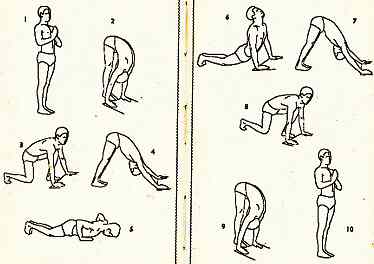
Comments
Post a Comment